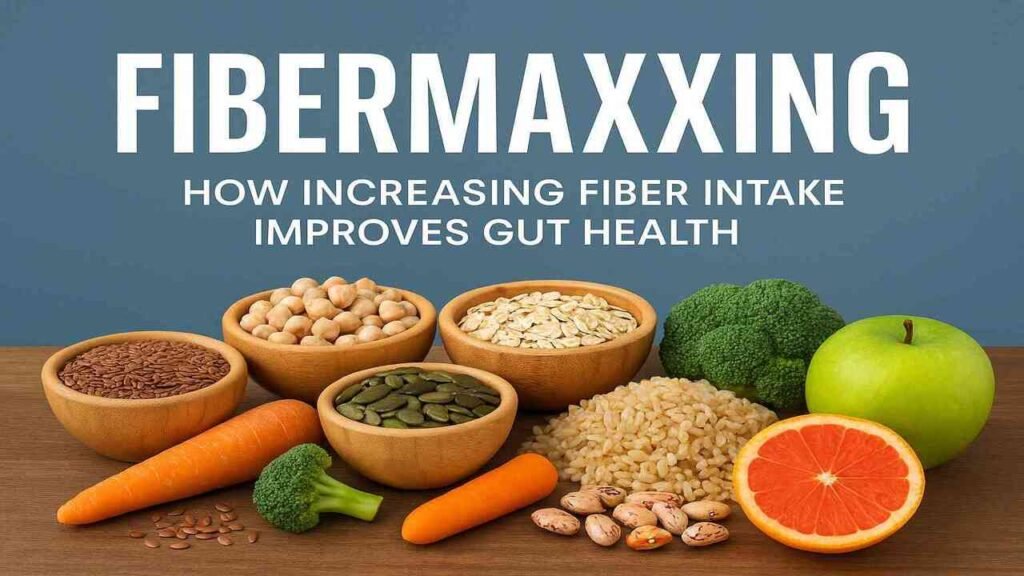Nutrition is full of trends. Some rise fast and fade quickly—detox teas, miracle shakes, and extreme diets. Others are rooted in real science and stick around for the long run. Fibermaxxing belongs to the second category. Unlike fads, fibermaxxing doesn’t require you to cut out food groups, follow strict fasting windows, or rely on expensive powders. Instead, it focuses on one simple, timeless principle: eat more fiber, and your gut—and body—will thank you.
Fibermaxxing has become a buzzword recently because people are rediscovering just how powerful fiber can be. The average adult consumes less than 15 grams of fiber per day, while the recommended intake is nearly double that. This shortfall is linked to constipation, digestive discomfort, and even chronic health conditions like diabetes, heart disease, and obesity. By intentionally raising fiber intake through everyday meals, people can improve digestion, stabilize energy, and protect long-term health.
In this article, we’ll explore what fibermaxxing means, why fiber is essential for gut health, the science behind different fiber types, the wide-ranging benefits of a fiber-rich diet, and practical strategies to add more fiber without discomfort.
What is Fibermaxxing?
Fibermaxxing is not a strict diet but an approach to eating that prioritizes fiber above all else. Instead of treating fiber as an afterthought—a side salad here, a sprinkle of flaxseed there—fibermaxxing makes it the foundation of meals.
At its core, the idea is simple: build meals around fiber-rich foods such as legumes, whole grains, vegetables, fruits, nuts, and seeds. Protein, healthy fats, and carbohydrates are still important, but they take supporting roles. By consistently centering fiber, you ensure that every meal helps feed your gut microbiome, regulate digestion, and provide sustained energy.
The term has gained popularity on social media wellness platforms, but the principle isn’t new. In fact, long-term studies have repeatedly shown that populations with high-fiber diets—such as those in parts of the Mediterranean, Asia, and Africa—tend to have lower rates of chronic disease and longer lifespans. Fibermaxxing is simply a modern way of framing a proven truth.
Why Fiber is Critical for Gut Health
Your gut is more than a digestive system—it’s a living ecosystem. Inside it lives trillions of microorganisms, collectively known as the gut microbiome. These microbes help digest food, synthesize vitamins, regulate the immune system, and communicate with the brain through the gut-brain axis.
Fiber plays a starring role in this ecosystem. Unlike sugars, fats, or proteins, fiber isn’t fully broken down in the small intestine. Instead, it reaches the large intestine, where gut bacteria ferment it into short-chain fatty acids (SCFAs) like butyrate, acetate, and propionate. These compounds act like chemical messengers and fuel sources:
- Butyrate nourishes colon cells and strengthens the intestinal barrier, preventing toxins from entering the bloodstream.
- Propionate helps regulate appetite and cholesterol production.
- Acetate supports energy balance and influences fat storage.
Without enough fiber, beneficial bacteria starve, and harmful species may dominate. This imbalance, known as dysbiosis, is associated with digestive discomfort, weakened immunity, inflammation, and even mood disorders.
Types of Fiber and Their Unique Benefits
Soluble Fiber
Soluble fiber dissolves in water, creating a gel-like texture in the gut. This slows digestion, which has two main effects: steadier blood sugar levels and reduced cholesterol absorption. Foods like oats, beans, apples, and carrots are excellent sources.
- Health benefit: Prevents energy crashes by avoiding sharp spikes in blood sugar.
- Gut benefit: Provides fuel for bacteria to produce SCFAs.
Insoluble Fiber
Insoluble fiber doesn’t dissolve in water. Instead, it passes through the digestive tract largely intact, adding bulk to stool and speeding bowel movements. Think of it as a broom that sweeps the intestines clean. Sources include whole grains, nuts, and fibrous vegetables like broccoli and kale.
- Health benefit: Prevents constipation and keeps digestion regular.
- Gut benefit: Creates a healthy environment by reducing transit time and lowering toxin exposure.
Resistant Starch
Resistant starch is a type of carbohydrate that resists digestion in the small intestine. It reaches the colon intact and becomes food for gut bacteria. Found in foods like cooked-and-cooled potatoes, green bananas, lentils, and oats, resistant starch is especially powerful at boosting microbiome diversity.
- Health benefit: Improves insulin sensitivity and blood sugar control.
- Gut benefit: Strong prebiotic effect, encouraging beneficial bacteria to thrive.
Prebiotic Fiber
Prebiotics are a category of fiber that specifically feed beneficial bacteria. Foods like garlic, onions, asparagus, and chicory root are rich in prebiotic fiber. By selectively nourishing “good” bacteria, prebiotics crowd out harmful microbes.
- Health benefit: Enhances immunity and mineral absorption.
- Gut benefit: Improves microbial diversity, a key marker of gut health.
Health Benefits of Fiber Beyond Digestion
Better Blood Sugar Control
When you eat refined carbohydrates, glucose is quickly absorbed, causing spikes in blood sugar. Over time, this can lead to insulin resistance. Fiber slows the process, creating a steady release of sugar into the bloodstream. This is why high-fiber diets are protective against type 2 diabetes.
Improved Heart Health
Soluble fiber binds cholesterol in the gut, preventing it from being absorbed into the bloodstream. Consistently high fiber intake can lower LDL cholesterol levels and reduce the risk of heart attack and stroke.
Natural Weight Management
Fiber-rich foods are filling yet relatively low in calories. Because they take longer to chew and digest, they promote satiety, reducing overeating. People who increase fiber intake often find it easier to manage their weight without extreme dieting.
Reduced Colon Cancer Risk
Large studies have linked high fiber consumption to lower rates of colorectal cancer. This is partly due to healthier bowel movements and partly due to SCFAs like butyrate, which have anti-inflammatory and anti-cancer properties.
Support for Mental Health
The gut-brain axis is real: gut bacteria produce neurotransmitters and influence inflammation, both of which affect mood. A fiber-rich diet, by supporting healthy bacteria, has been linked to lower levels of anxiety and depression.
Practical Strategies to Fibermaxx Safely
Start Slowly
Jumping from a low-fiber diet to a very high one can lead to gas, bloating, and cramps. Increase intake gradually, adding 5 grams every few days until you reach 30–40 grams.
Focus on Variety
Each type of fiber has unique effects, so it’s not enough to eat the same food daily. A diverse mix of legumes, grains, fruits, vegetables, nuts, and seeds ensures maximum benefit.
Drink More Water
Fiber needs water to do its job. Without enough fluids, a high-fiber diet can backfire, causing constipation. Pair fibermaxxing with an extra 1–2 glasses of water daily.
Prioritize Whole Foods
Supplements like psyllium husk are helpful, but they lack the vitamins, minerals, and antioxidants found in whole foods. Aim to get at least 80% of fiber from food sources.
Make Small, Lasting Swaps
- Replace refined grains with whole grains.
- Swap chips for roasted chickpeas.
- Add vegetables to pasta dishes.
- Choose fruit instead of juice.
Fibermaxxing in Action: A Sample Day
- Breakfast: Overnight oats with chia seeds, flaxseed, blueberries, and almond butter.
- Snack: An apple with a handful of walnuts.
- Lunch: Lentil and quinoa salad with spinach, roasted vegetables, and olive oil.
- Snack: Carrot sticks with hummus and pumpkin seeds.
- Dinner: Grilled salmon with brown rice, steamed broccoli, and a side of lentil soup.
- Dessert: A square of dark chocolate with raspberries.
This day alone provides over 40 grams of fiber in a delicious, balanced way.
Common Myths About Fiber
Myth 1: Fiber is only for constipation.
In reality, fiber supports blood sugar control, heart health, weight management, and even mood.
Myth 2: Supplements are the only way to get enough fiber.
Whole foods are far superior because they provide multiple nutrients in addition to fiber.
Myth 3: All fiber is the same.
Different fibers (soluble, insoluble, resistant starch, prebiotics) play different roles in health.
Challenges and How to Overcome Them
- Busy lifestyles: Use frozen or pre-cut vegetables and batch-cook legumes.
- Digestive sensitivity: Start with cooked vegetables and soluble fiber before moving to raw greens or beans.
- Taste preferences: Experiment with herbs, spices, and creative recipes to make fiber-rich foods enjoyable.
Frequently Asked Questions (FAQ)
Q1. How much fiber should I eat daily to fibermaxx?
Most adults should aim for 25–35 grams daily, but fibermaxxing usually means pushing closer to 40 grams, depending on tolerance.
Q2. Can too much fiber be harmful?
Yes. Excessive fiber without hydration or gradual buildup can cause bloating, gas, or constipation. Balance and moderation matter.
Q3. Is fibermaxxing safe for children?
Children also benefit from fiber, but their needs are lower. A pediatrician can provide age-appropriate recommendations.
Q4. Which is better—soluble or insoluble fiber?
Both are important. Soluble fiber helps with cholesterol and blood sugar, while insoluble fiber supports bowel regularity.
Q5. Do I need supplements if I eat enough vegetables?
If your diet is balanced, supplements may not be necessary. They are best used as a backup, not a primary source.
Fibermaxxing may sound trendy, but it represents one of the most enduring lessons in nutrition: a fiber-rich diet supports nearly every system in the body. By prioritizing legumes, whole grains, fruits, vegetables, nuts, and seeds, you not only improve digestion but also reduce the risk of chronic illness, manage weight, and even support mental well-being.
Unlike complicated diets, fibermaxxing is simple, affordable, and accessible. The challenge is consistency. By making fiber the foundation of your meals and gradually building intake, you can transform your gut health and enjoy lasting benefits for years to come.





